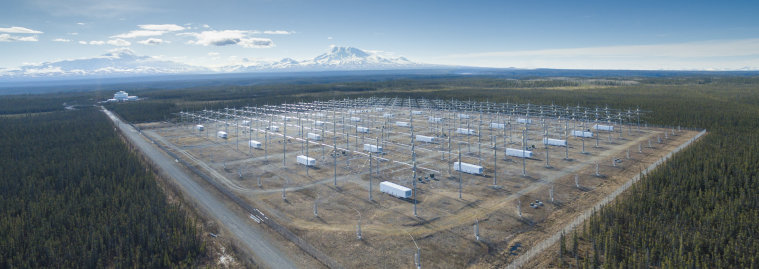 (Source: University of Alaska Fairbanks News)
(Source: University of Alaska Fairbanks News)
UAF plans HAARP research campaign
The University of Alaska Fairbanks Geophysical Institute is planning its first research campaign at the High Frequency Active Auroral Research Program facility in Gakona.
At the end of February, scientists will use the HAARP research instrument to conduct multiple experiments, including a study of atmospheric effects on satellite-to-ground communications, optical measurements of artificial airglow and over-the-horizon radar experiments.
Members of the public can follow one of the experiments in real time. Chris Fallen, assistant research professor in space physics, will be conducting National Science Foundation-funded research to create an “artificial aurora” that can be photographed with a sensitive camera. Observers throughout Alaska will have an opportunity to photograph the phenomenon, which is sometimes created over HAARP during certain types of transmissions.
Under the right conditions, people can also listen to HAARP radio transmissions from virtually anywhere in the world using an inexpensive shortwave radio. Exact frequencies of the transmission will not be known until shortly before the experiment begins, so follow @UAFGI on Twitter for an announcement.
For more details on the dates and times of Fallen’s experiments, as well as information on how to observe, visit https://sites.google.com/alaska.edu/gakonahaarpoon/. Information is also available at the HAARP website, the UAF http://gi.alaska.edu/haarp-0 and the official UAF HAARP Facebook page, https://www.facebook.com/UAFHAARP/.
Operation of the HAARP research facility, including the world’s most capable high-power, high-frequency transmitter for study of the ionosphere, was transferred from the U.S. Air Force to UAF in August 2015.
Research funding agencies include the National Science Foundation, Department of Energy’s Los Alamos National Lab and the Naval Research Laboratory.
ADDITIONAL CONTACTS: Contact HAARP personnel with any questions at [email protected].

Sounds interesting, to bad I don’t have Twitter.
Only a web browser is needed! No twitter account or sign-in is required!
https://twitter.com/ctfallen
I don’t know, It’s interesting, but it wasn’t because when they had HARRP fully operational it caused severe weather events, and it really scared me. Just take a look at HARRP on you tube. Many you tubers are trying their best to tell the truth about this HARRP program. I don’t want to relive history again. Research and read about it before participating in such HF experiments.
The HAARP facility is now operated by the University of Alaska Fairbanks. Frequencies and times are not classified (nothing about the facility has been classified, actually). Frequencies are usually determined shortly before each experiment based on experiment objectives and current ionosphere conditions. Times are often determined by a sort of horse-trading activity among scientists with sometimes overlapping needs.
I personally would like to repeat the earth-moon-earth experiment as well, in addition to listening tests similar to those performed early in the history of the facility. However, now that the operating model has changed, individual scientists need to secure funding for HAARP time, about $5000/hour (600+ gal/hour fuel, plus the salaries of the people to run the facility), so cases for these experiments need to be made to funding agencies such as NSF in the US. My funding this year is for artificial aurora (airglow) experiments, but I will attempt to include short “Luxembourg” type audio-frequency amplitude modulation experiments once or twice each day during my allocated times during the campaign.
I will do my best to provide updates on frequencies and times by twitter @ctfallen and through my website for this project linked above (gakonaHAARPoon).
Thank you Christopher. If you think about it, drop me a line before experiments and I’ll post details here. thomas [at] swling.com.
-Thomas
Pretty please, I check this blog daily and don’t use twitter either, so this would be great! I don’t want to miss the shows this time, now I’d even have a waterfall display and a proper antenna roughly beaming towards AK. 🙂
Thank you. I will try to at least pass along the time and date of my experiments when I am able to do that.
However, frequencies and modes are often adjusted shortly before the experiment in response to changing ionospheric conditions or sometimes equipment issues, so the social media outlets linked in the press release are the easiest ways for us to provide near real-time information at the moment.
For my experiments, I am operating two cameras remotely, monitoring an ionosonde, potentially some radio receivers, and making appropriate adjustments to the experiment. Consequently I will probably only barely have time to update my personal twitter, which can be accessed through a normal web browser at the url
https://twitter.com/ctfallen
(No twitter log-in or account is required)
I wish they would repeat the earth-moon-earth experiment they did some years ago. I totally missed it.
Does not specifically say which frequencies at which times. Probably classified information. not sure how the average rank and file SWL could participate.
Oh, I think it’ll be open to all. I have a hunch they’ll publish updates with opportunities. I’ll contact them and make sure we’re on their “propagation” list!
Not classified.. but the exact frequency being used depends on the experiment and the specific ionospheric conditions.
I’m speaking as a previous HAARP experimenter. You can’t know more than about 15 minutes ahead of time the exact frequency you’ll need for an artificial aurora experiement.
Generally for artificial auroral experiments they have to match the frequency to the specific peak plasma density altitude. They operate a low power scanning ionosonde which essential provides the plasma density profile every few minutes and then pick the main transmitter frequency based on the ionosonde analysis.
For real time operational updates.. follow @UAFGI on twitter as the article suggests.
-jef
It’s not classified, all SWLs are able to participate, go to: https://sites.google.com/alaska.edu/gakonahaarpoon/
The links at the top of the page have instructions on tuning in and will be updated during operations…
You can also follow @UAFGI on Twitter for the announcements prior to the experiments.